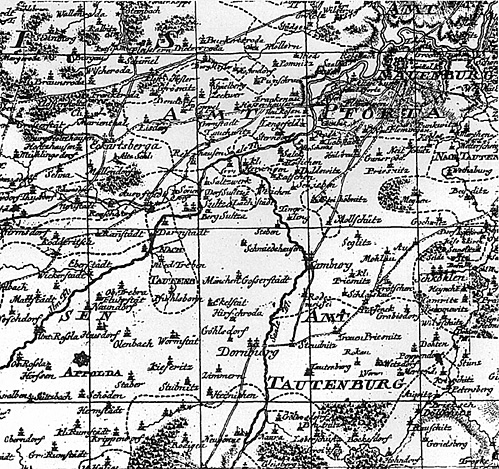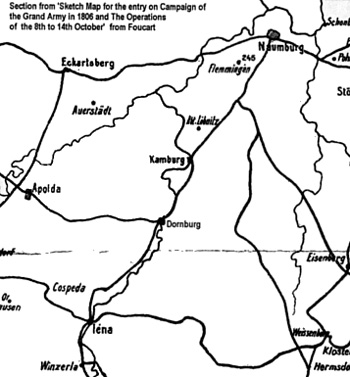Bernadotte 1806
Is There A Case For The Defence?
Introduction
by John Cook
| |
Bernadotte commanded I Corps, which immediately before the twin battles of Jena and Auerstädt on 14 October 1806 formed, together with Marshal Davout's III Corps, the right wing of the Grand Army, the purpose of which was to fall on the left and rear of the main Prussian army, which Napoleon expected to fight somewhere in the vicinity of Weimar on or about 16 October.
To this end, on 12 October, following reports from Murat which indicated that the Prussian army was concentrating at Erfurt some 12 miles to the west of Weimar, Napoleon drafted a concept of operations for the concentration of the army, in which Davout and Bernadotte were to be at Apolda and Dornburg respectively on 14 October.
Meanwhile, the Prussian council of war, comprising no less than twelve officers, had met on 5th October in a futile attempt to resolve the differing plans of campaign proposed by the various factions, essentially those of Brunswick on the one side, Hohenlohe and Massenbach on the other. The council broke up agreeing to do nothing until 8th October! Finally, on 10 October, all ideas of an offensive campaign were abandoned and Brunswick gave orders that the widely dispersed Prussian forces were to withdraw in an attempt to concentrate west of the Saale. This was never realised as the orders did not reach their recipients in time and movements were delayed until the morning of 11th October, by which time Prince Louis had already been defeated at Saalfeld the previous day.
By the time Napoleon received the reports of 12 October, the Prussian army was disposed as follows. Hohenlohe was at Jena, camped on the plateau above the town, Rüchel was in Weimar, and Brunswick, with the main army, was camped at Umpferstedt east of Weimar. Reports confirming the presence of the French in Jena prompted the convening of yet another council of war for the morning of 13th October.
The decision was taken to retreat on the Elbe with the main army, in the direction of Kösen. Hohenlohe was ordered to remain in his position above Jena, the intention being that he should follow and rejoin the main army on the 14th October. By 1200 on 13th October the main Prussian army was on the march towards Auerstädt, which it reached late that night. Thus, on 14th October the dispositions of the Prussian forces, which were to be destroyed that day, were Hohenlohe above Jena, Rüchel at Weimar and the main army at Auerstädt.
In the event Napoleon's appreciation was wrong, both in the location of the main Prussian army but also in the context of the date on which he expected to fight it. In the circumstances this was not Napoleon's fault; he could only act on the information he received. Furthermore, it may be doubted that he was ever entirely clear about enemy intentions, due largely to inability of the competing factions of the Prussian council of war to agree on a cogent plan of campaign, resulting in the bizarre movements of the enemy army very briefly described above.
Be that as it may, as is well known, the Prussian army destroyed at Jena was not the main body he expected to find but a detachment of some 40,000 to 50,000 men under command of Hohenlohe, Indeed, even after the battle of Jena was over Napoleon initially refused to believe that this was the case and when he received news of Davout's remarkable victory at Auerstädt from Colonel Falcon, Davout's aide de camp, he responded with "Your marshal must have been seeing double.". Auerstädt was never to feature as a Napoleonic battle honour.
This article, however, is not concerned with either Jena or Auerstädt, but the series of events that resulted in Bernadotte's I Corps, amongst others, taking no part in either. It does not seek to exonerate Bernadotte from all criticism but attempts to explain why he acted in the way that he did.
Map
Section from Petri's map of Saxony dated 1763--inaccurate and outdated by 1806. It was from this inadequate cartography than Napoleon planned the destruction of the Prussian army. Principle roads in 1806, primarily the one connecting Dornberg to Apolda, were not shown. For orientation, Naumberg is top right, Jena at bottom left.

Jumbo 1763 Map of 1806 Operations Area (extremely slow: 471K) More Bernadotte and 1806
Bernadotte and 1806: Prosecution's Case Bernadotte and 1806: Defense's Evidence Bernadotte and 1806: Defense's Case Bernadotte and 1806: The Villain: Bernadotte Bernadotte and 1806: The Hero: Davout Bernadotte and 1806: Plan A and B Maps (very slow: 288K) A Footnote To Bernadotte: Scapegoat for Intelligence Failure? Back to Table of Contents -- First Empire #48 Back to First Empire List of Issues Back to MagWeb Master Magazine List © Copyright 1999 by First Empire. This article appears in MagWeb (Magazine Web) on the Internet World Wide Web. Other military history articles and gaming articles are available at http://www.magweb.com |

 If Marshal Bernadotte's career is not one that attracts particular attention, in comparison with some of his peers, it is his performance in 1806 that attracts most adverse comment.
If Marshal Bernadotte's career is not one that attracts particular attention, in comparison with some of his peers, it is his performance in 1806 that attracts most adverse comment.